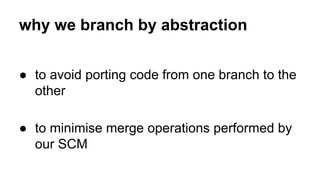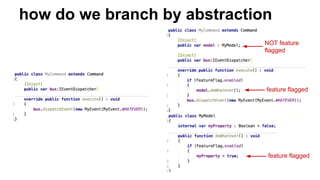Branching by abstraction
- 1. why we need to branch ‚óè write new code without affecting old code ‚óè build and test new code in staging environments without affecting production
- 2. why we branch by abstraction ‚óè to avoid porting code from one branch to the other ‚óè to minimise merge operations performed by our SCM
- 3. we branch by abstraction not to be changing our code but to configure our code
- 4. when do we branch by abstraction ‚óè we have to develop a new feature ‚óè we have to change an existing feature
- 5. how do we branch by abstraction feature flagged feature flagged NOT feature flagged
- 6. how do we test feature flags
- 7. how do we test feature flags
- 8. what happens when we release ‚óè remove feature flag from command ‚óè remove feature flag from model ‚óè remove feature flag from the command test ‚óè remove feature flag from the model test ‚óè run the tests again to see that everything is still working ‚óè ...and we LOST the previous implementation!
- 9. we branch by abstraction not to be changing our code but not to configure our code
- 10. a possible solution: NO FLAGS!
- 11. a possible solution: CONFIGURATION Robotlegs Parsley
- 12. Solution ProsCons Pros: ‚óè focusing only on the needed behavior without touching the previous class ‚óè rely on previous implementations and tests ‚óè cleaner tests against cleaner classes ‚óè only one place for feature flags ‚óè easy to revert/promote code from/to release ‚óè no feature loss Cons: ‚óè not a silver bullet for everything for sure ‚óè any suggestion?
- 13. we branch by abstraction not to be changing our code but to configure our code












